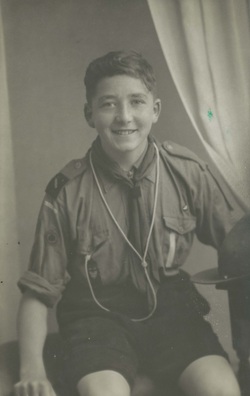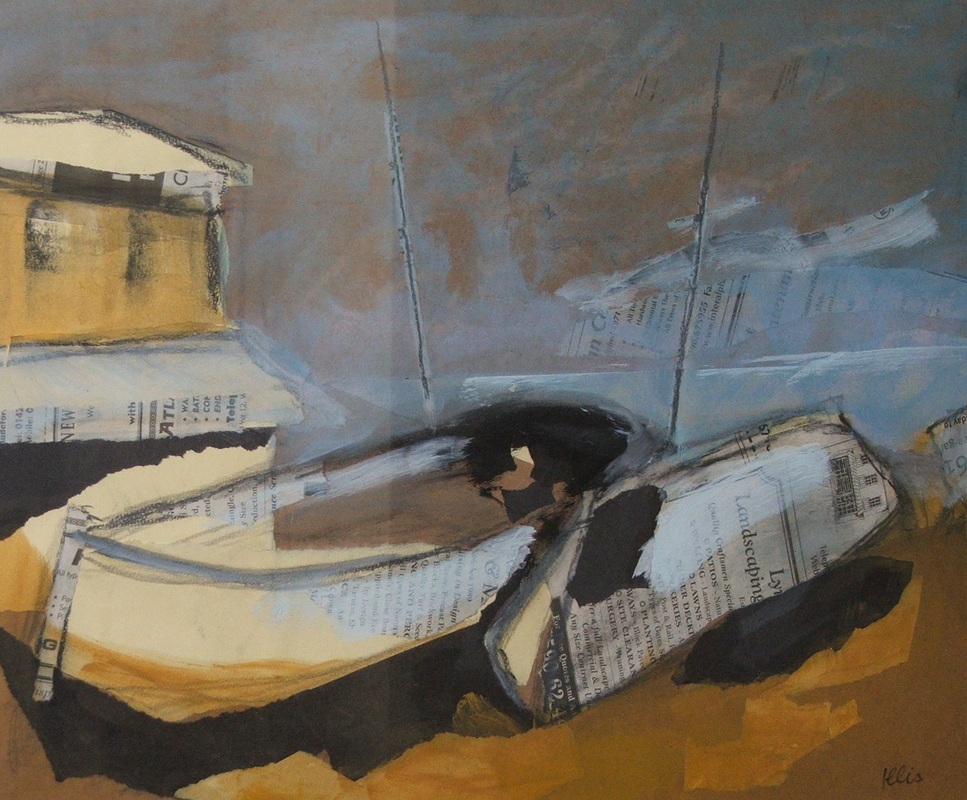Biography

Lee in boy scout uniform in 1943, aged 13
Born in 1930 in the East End of London, the youngest of 8 children, Lee grew up in a one bedroom house with no bathroom and an outside lavatory. his father died when he was only 3 years old and his mother raised an extremely loving and happy family single-handed. During the war, he was evacuated to a farm in rural Norfolk, which fostered in him an abiding love of the countryside. After the war, he returned to London and attended Hackney Downs School, where his contemporaries included Harold Pinter; Michael Caine (or Maurice Micklewhite, as he as then known) and a future head of Mossad.
Lee did his National Service in the Army, commissioned as a subaltern in the Royal Artillery, spending most of his 2 years in Germany learning to fence, ride, sail and kill people, mostly ineffectively. The most salutary experience of his army career was visiting Belsen, whose silent screaming stones still haunt him. After leaving the army he applied for medical school and won a scholarship to University College Hospital. He was awarded the anatomy scholarship at University College London and demonstrated anatomy to students from the Slade School, where he developed his interest in art. As anatomy scholar in J Z Young's department, he became interested in the nervous system and began experimental work on central nervous regeneration and reorganisation, which was later to become part of his MD thesis. His first published paper was in the 1960s and the most recent was in 2012, although the one that arguably caused the greatest stir was his 1964 paper in the Proceedings of the Royal Society of Medicine, On Porphyria and the Aetiology of Werewolves, in which he first proposed the hypothesis - now generally accepted as fact - that the root of the werewolf myth lies in a rare form of congenital porphyria. Lee has had papers published in Brain, Spinal Cord, Experimental Neurology and Nature. He represented his university in sailing and fencing and was in the finals of the Great Britain epée championship.
After university, he went on to specialize in neurology; marry Oonagh in 1967 and move out of London; first to Southampton in 1968 and then on to the New Forest in 1972, where his three sons, Max, Ben and Sebastian were born. Based at the Wessex Neurological Centre in Southampton University, he enjoyed an illustrious career, working and teaching all over the world. He was elected president of the South of England Neurosciences Association; president of the International Neuromodulation Society and chair of the Scientific Committee of the International Spinal Research Trust. He was visiting professor at Madison, Wisconsin; Houston, Texas and at the Ceylon College of Physicians, Sri Lanka, where he was twice awarded the gold medal. He was also awarded the medal of the International Spinal Research Society. On his retirement, he was honoured to be asked to edit Spinal Cord, part of the Nature Publishing Group, which he went on to do for ten years. In 2006, when Lee retired from the editorship of Spinal Cord, a colleague and fellow member of the journal's board, Professor Milan Dimitrijevic, wrote this editorial, which highlights some of his many achievements.
In his retirement, he took up painting and life-drawing, hobbies he had wanted to pursue since his days demonstrating to students at the Slade. He was tutored by the late Fred Sinkinson, former President of the New Forest Art Society in Lyndhurst, Hampshire. He also started to work with a close family friend, the British artist Pauline Keaney, who lives and works on the Greek island of Hydra, where Lee and his family have spent summer holidays for over two decades. Fred and Pauline persuaded him to enter "Kamini Boats" (below) for the John Moores Contemporary Painting Prize, for which he was short-listed in 2006.
Over the years, he has developed a strong, distinctive and painterly style in his canvasses. He often uses thick layers of oil paint applied to large canvasses with a palette knife or large brush, giving a strong sense of depth and texture. These textures are further worked and filtered through layers of thinner paint; washes and glazes. He also uses elements of collage and other mixed media in his work. He still works mainly in oil paint on canvas, brown paper or board, also making significant use of oil pastels and sketching in pencil; pen and ink and charcoal, often tinting his sketches with an oil wash.
He still lives on the edge of the New Forest, an area which he has made home to his family for over 40 years, where he continues to do medico-legal work and, of course, paint and sketch.
Many of Lee's original paintings and sketches, as well as prints and greetings cards, are for sale. Please contact his son Ben for more information about gallery stockists and price
Lee did his National Service in the Army, commissioned as a subaltern in the Royal Artillery, spending most of his 2 years in Germany learning to fence, ride, sail and kill people, mostly ineffectively. The most salutary experience of his army career was visiting Belsen, whose silent screaming stones still haunt him. After leaving the army he applied for medical school and won a scholarship to University College Hospital. He was awarded the anatomy scholarship at University College London and demonstrated anatomy to students from the Slade School, where he developed his interest in art. As anatomy scholar in J Z Young's department, he became interested in the nervous system and began experimental work on central nervous regeneration and reorganisation, which was later to become part of his MD thesis. His first published paper was in the 1960s and the most recent was in 2012, although the one that arguably caused the greatest stir was his 1964 paper in the Proceedings of the Royal Society of Medicine, On Porphyria and the Aetiology of Werewolves, in which he first proposed the hypothesis - now generally accepted as fact - that the root of the werewolf myth lies in a rare form of congenital porphyria. Lee has had papers published in Brain, Spinal Cord, Experimental Neurology and Nature. He represented his university in sailing and fencing and was in the finals of the Great Britain epée championship.
After university, he went on to specialize in neurology; marry Oonagh in 1967 and move out of London; first to Southampton in 1968 and then on to the New Forest in 1972, where his three sons, Max, Ben and Sebastian were born. Based at the Wessex Neurological Centre in Southampton University, he enjoyed an illustrious career, working and teaching all over the world. He was elected president of the South of England Neurosciences Association; president of the International Neuromodulation Society and chair of the Scientific Committee of the International Spinal Research Trust. He was visiting professor at Madison, Wisconsin; Houston, Texas and at the Ceylon College of Physicians, Sri Lanka, where he was twice awarded the gold medal. He was also awarded the medal of the International Spinal Research Society. On his retirement, he was honoured to be asked to edit Spinal Cord, part of the Nature Publishing Group, which he went on to do for ten years. In 2006, when Lee retired from the editorship of Spinal Cord, a colleague and fellow member of the journal's board, Professor Milan Dimitrijevic, wrote this editorial, which highlights some of his many achievements.
In his retirement, he took up painting and life-drawing, hobbies he had wanted to pursue since his days demonstrating to students at the Slade. He was tutored by the late Fred Sinkinson, former President of the New Forest Art Society in Lyndhurst, Hampshire. He also started to work with a close family friend, the British artist Pauline Keaney, who lives and works on the Greek island of Hydra, where Lee and his family have spent summer holidays for over two decades. Fred and Pauline persuaded him to enter "Kamini Boats" (below) for the John Moores Contemporary Painting Prize, for which he was short-listed in 2006.
Over the years, he has developed a strong, distinctive and painterly style in his canvasses. He often uses thick layers of oil paint applied to large canvasses with a palette knife or large brush, giving a strong sense of depth and texture. These textures are further worked and filtered through layers of thinner paint; washes and glazes. He also uses elements of collage and other mixed media in his work. He still works mainly in oil paint on canvas, brown paper or board, also making significant use of oil pastels and sketching in pencil; pen and ink and charcoal, often tinting his sketches with an oil wash.
He still lives on the edge of the New Forest, an area which he has made home to his family for over 40 years, where he continues to do medico-legal work and, of course, paint and sketch.
Many of Lee's original paintings and sketches, as well as prints and greetings cards, are for sale. Please contact his son Ben for more information about gallery stockists and price
